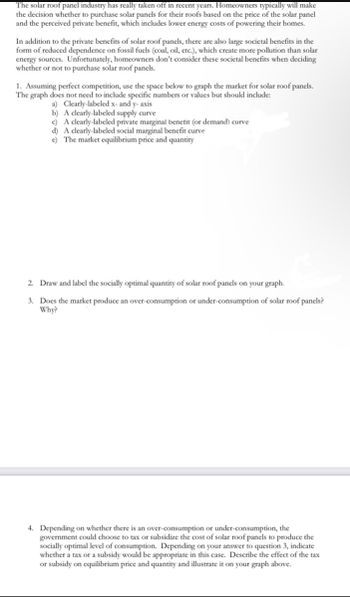
ENGR.ECONOMIC ANALYSIS
14th Edition
ISBN: 9780190931919
Author: NEWNAN
Publisher: Oxford University Press
expand_more
expand_more
format_list_bulleted
Question
Answer to question #4

Transcribed Image Text:The solar roof panel industry has really taken off in recent years. Homeowners typically will make
the decision whether to purchase solar panels for their roofs based on the price of the solar panel
and the perceived private benefit, which includes lower energy costs of powering their homes.
In addition to the private benefits of solar roof panels, there are also large societal benefits in the
form of reduced dependence on fossil fuels (coal, oil, etc.), which create more pollution than solar
energy sources. Unfortunately, homeowners don't consider these societal benefits when deciding
whether or not to purchase solar roof panels.
1. Assuming perfect competition, use the space below to graph the market for solar roof panels.
The graph does not need to include specific numbers or values but should include:
a) Clearly-labeled x- and y-axis
b) A clearly-labeled supply curve
c) A clearly-labeled private marginal benefit (or demand) curve
d) A clearly-labeled social marginal benefit curve
e) The market equilibrium price and quantity
2. Draw and label the socially optimal quantity of solar roof panels on your graph.
3. Does the market produce an over-consumption or under-consumption of solar roof panels?
Why?
4. Depending on whether there is an over-consumption or under-consumption, the
government could choose to tax or subsidize the cost of solar roof panels to produce the
socially optimal level of consumption. Depending on your answer to question 3, indicate
whether a tax or a subsidy would be appropriate in this case. Describe the effect of the tax
or subsidy on equilibrium price and quantity and illustrate it on your graph above.
Expert Solution
This question has been solved!
Explore an expertly crafted, step-by-step solution for a thorough understanding of key concepts.
Step by stepSolved in 3 steps with 1 images

Knowledge Booster
Learn more about
Need a deep-dive on the concept behind this application? Look no further. Learn more about this topic, economics and related others by exploring similar questions and additional content below.Similar questions
- I need the answer to four, but it requires number 3.arrow_forwardWhen the price of salad was $5, a cafeteria sold 50 packets of salad dressing a day at $0.50 per packet. When they increased the price of salad by 40%, but kept the dressing at the same price, they sold 50% fewer packets of salad dressing.arrow_forwardAnswer this questionarrow_forward
- Question 35 What have you learned about Microeconomics that you did not know before taking this class?arrow_forward* MindTap - Cengage Learning b Answered: Homework (Ch 17) En x + A ng.cengage.com/static/nb/ui/evo/index.html?deploymentld=59828118170010561930692029148&elSBN=9780357133606&id=1270090919&snapshotld=2556323& E Apps M Gmail A Maps A clickserve.dartsearc. E Reading list YouTube « * CENGAGE MINDTAP Q Search this course Love v A My Home Homework (Ch 17) Courses Complete the following table by indicating whether each of the scenarios describes the concept of tying, resale price maintenance, or predatory O Catalog and Study Tools pricing. Resale Price Predatory Pricing A-Z EE Rental Options Scenario Tying Maintenance Coolaire is the only firm producing refrigerators. It costs $1,000 to produce a refrigerator, and - College Success Tips Coolaire sells each refrigerator for $1,200. After Chillbox, a new firm with the same costs as Career Success Tips Coolaire, enters the market for refrigerators, Coolaire starts selling its refrigerators for a price of $550. ? Help Snackyville sells a wide…arrow_forward
arrow_back_ios
arrow_forward_ios
Recommended textbooks for you

 Principles of Economics (12th Edition)EconomicsISBN:9780134078779Author:Karl E. Case, Ray C. Fair, Sharon E. OsterPublisher:PEARSON
Principles of Economics (12th Edition)EconomicsISBN:9780134078779Author:Karl E. Case, Ray C. Fair, Sharon E. OsterPublisher:PEARSON Engineering Economy (17th Edition)EconomicsISBN:9780134870069Author:William G. Sullivan, Elin M. Wicks, C. Patrick KoellingPublisher:PEARSON
Engineering Economy (17th Edition)EconomicsISBN:9780134870069Author:William G. Sullivan, Elin M. Wicks, C. Patrick KoellingPublisher:PEARSON Principles of Economics (MindTap Course List)EconomicsISBN:9781305585126Author:N. Gregory MankiwPublisher:Cengage Learning
Principles of Economics (MindTap Course List)EconomicsISBN:9781305585126Author:N. Gregory MankiwPublisher:Cengage Learning Managerial Economics: A Problem Solving ApproachEconomicsISBN:9781337106665Author:Luke M. Froeb, Brian T. McCann, Michael R. Ward, Mike ShorPublisher:Cengage Learning
Managerial Economics: A Problem Solving ApproachEconomicsISBN:9781337106665Author:Luke M. Froeb, Brian T. McCann, Michael R. Ward, Mike ShorPublisher:Cengage Learning Managerial Economics & Business Strategy (Mcgraw-...EconomicsISBN:9781259290619Author:Michael Baye, Jeff PrincePublisher:McGraw-Hill Education
Managerial Economics & Business Strategy (Mcgraw-...EconomicsISBN:9781259290619Author:Michael Baye, Jeff PrincePublisher:McGraw-Hill Education


Principles of Economics (12th Edition)
Economics
ISBN:9780134078779
Author:Karl E. Case, Ray C. Fair, Sharon E. Oster
Publisher:PEARSON

Engineering Economy (17th Edition)
Economics
ISBN:9780134870069
Author:William G. Sullivan, Elin M. Wicks, C. Patrick Koelling
Publisher:PEARSON

Principles of Economics (MindTap Course List)
Economics
ISBN:9781305585126
Author:N. Gregory Mankiw
Publisher:Cengage Learning

Managerial Economics: A Problem Solving Approach
Economics
ISBN:9781337106665
Author:Luke M. Froeb, Brian T. McCann, Michael R. Ward, Mike Shor
Publisher:Cengage Learning

Managerial Economics & Business Strategy (Mcgraw-...
Economics
ISBN:9781259290619
Author:Michael Baye, Jeff Prince
Publisher:McGraw-Hill Education